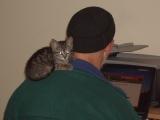Not a drop
Umm Shams, a biochemist who works for the Health Ministry, says the government insists that water provided through municipal wells is safe for drinking. But she l
"I don't know exactly where it comes from," she said of the water that surges through the hose. "Now it smells," she added, wrinkling her nose.
The USAID website boasts its reconstruction accomplishments have restored potable water to Iraqis.
Kerkh wastewater treatment plant (WTP) began operating on May 19, 2004, the first major Iraqi plant to operate at full capacity in more than 12 years.
Standby generators have been procured and installed at 27
Tina Susman and Zeena Kareem report in today’s LA Times several children under 12 have been diagnosed with cholera in Najaf, an ominous sign before summer has even begun. Claire Hajaj of the United Nations Children's Fund, or UNICEF, said cholera outbreaks usually don't arise until July, when temperatures can soar above 120 degrees (F =49 C).
As the temperature rises, Iraq's chronic electricity shortages make it difficult to operate pumps at sewage and drinking-water treatment plants, creating a dangerous mix of desperate people and dirty water.
"Water is an enormous need and people take it where they can get it, and they are getting it from places where it is not always clean," she said.
In the capital alone, at least 135,000 residents depend on water from tanker trucks. Tens of thousands of Iraqis bore holes into the ground outside their houses and businesses and pump their own ground water.
Municipal water, meanwhile, often comes through cracked and dirty pipes that were neglected under Hussein and have been further damaged by four years of war.
Even Umm Shams' home has been without electricity for two days, she said, looking at the still fan hanging from the ceiling of the small, neat living room.
The U.N. estimates that only 17% of Iraqi sewage is being treated bec
Most sewage pours into the Tigris and
Curiously, however, USAID claims
Expanded Sharq Dijlah water plant by 50 MGD and rehabilitated three sewage plants, which serve 80 percent of
Who do you believe?





No comments:
Post a Comment